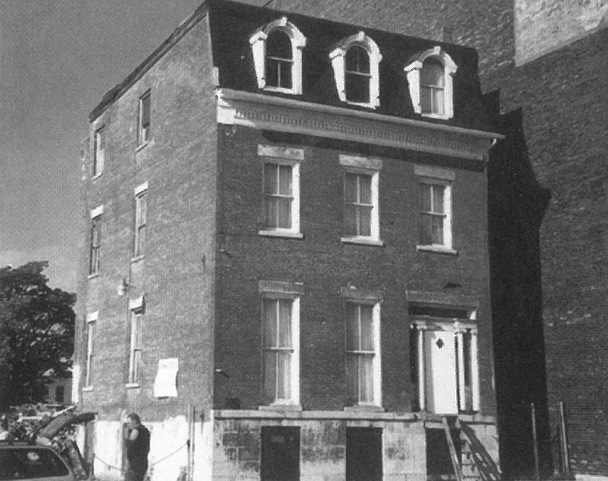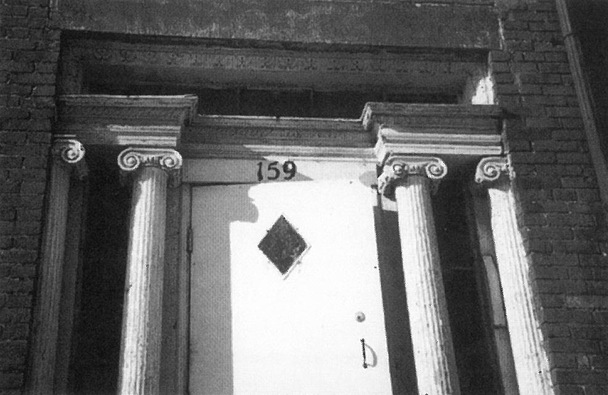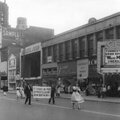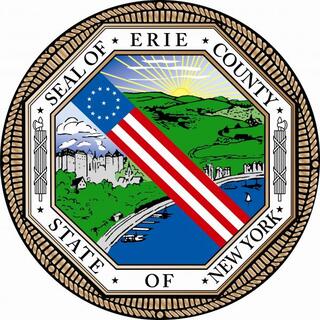In the midst of a court-ordered demolition, twenty-four hours before complete obliteration, the front part of the old brick house seemed, momentarily, to recapture some of its former dignity as it stood to meet the executioner. The circa, 1835 Greek Revival row house, the last and best of its tribe, was the vestige of a unique educational institution originated in Buffalo; but, (only a block away from Erie Community College), it had become a stranger in its native land, guarding a history no one cared to hear.
Even as an anonymous piece of architecture, the building was a prime example of the brick row house common to early Buffalo. It was a local landmark, although the three Italianate dormers in a mansard roof added in the 1860s caused the building to be listed as a Civil War era house. Originally, it had parapet gable walls that were probably connected by a balustrade across the facade. Above a high basement faced with cut stone, the Greek Revival doorway articulated into transom and sidelights by fluted Ionic columns, was the epitome of its type and style in early Buffalo. The original door had been replaced.
On the interior, the plan of the front part of the house had remained intact for 160 years. The doorways to the parlor and dining room were trimmed the original wide casings of Grecian moldings, set-off in high style by large, boldly sculpted corner blocks. The same generously proportioned woodwork remained on a pair of dining room windows, trimmed floor-to-ceiling. Between the windows was an elegantly sculpted polished grey marble mantle. It was completely intact and contained a black cast iron firebox frame with Greek Revival detailing, probably forged in Buffalo at Sherman Jewett’s Eagle Iron Works.
Swan Street is said to have been one of the main “social centers” of the young city of Buffalo. If so, this house, vacant for nearly twenty years (and an ill-reputed boarding house before that), would have been part of that social scene. Samuel Welch mentions Swan Street as the home of many “locally historical, time-honored people.” He cites the Hempstead & Keeler Block on Swan between Elm and Oak, an address second only to the Darrow Block, containing row houses “then considered fashionable, palatial, first class city houses.” The Swan Street neighbors of 159 included: Joseph Stocking, Joseph Dart, Roswell Haskins, Joseph Masten, Thomas Cary, Aaron Rumsey, Dr. Sylvester Mixer, Myron Bush, Sherman Jewett and ship captains Imson and Hazard.
Who, then, of the city’s world-beaters might not have come calling at this columned doorway?
Benjamin Fitch, a Buffalo native who had made a fortune in the dry goods business, and who had become a noted philanthropist resident of New York City, was the owner of the house in 1879. But the house was not built to be the home of Benjamin Fitch. The house at the corner of Swan and Michigan was built as the city home of Lucius H. Pratt, a lakes shipping merchant who had a commission warehouse on the Buffalo River at the foot of Michigan at the Pratt Slip. The house was built on land originally deeded to his father Samuel Pratt before the burning of Buffalo in 1813.
Lucius Pratt was the brother of Samuel F. Pratt and Pascal P. Pratt. He was born in Buffalo in 1809, the second son of Samuel and Sophia Fletcher Pratt. He was married first to Cynthia Weed, who died in 1843. His second wife was Susan Beals, daughter of John W. Beals. They were married in 1844 and had six children between 1845 and 1854, all while living in this house. Hiram Pratt, Mayor of Buffalo at the time this house was built, was a brother of Lucius’ father and a nearby neighbor on Swan Street. The south side of Swan Street, above and below Michigan Avenue, was Pratt domain. Lucius’ mother, widow Sophia Pratt, lived just east of Michigan, near her daughter and son-in-law Dr. Gorham Pratt. Samuel F. Pratt, the brother who founded the Pratt Hardware Co. and Pratt & Letchworth, lived two doors west at the corner of Pratt Alley. Nearby, opposite the Hempstead & Keeler Block, was the home of Orlando Allen, another Mayor of Buffalo, who was a partner with Hiram Pratt in the Frontier Mills at Black Rock. Orlando Allen, a man of great accomplishment, who lived out his life in the house he built on Swan Street in 1829, was married to Marilla Pratt, sister of Samuel Pratt. Swan Street in the area of this house thus constituted a who’s who of Buffalo leadership and business.
In her biography of William P. Letchworth, Irene Beale (Editor’s note: no relation to Beals) gives a vivid description of the social life of Buffalo in the 1840s in areas that included Swan Street. “There was much visiting back and forth among the handsome houses...dinner parties were in constant rotation from home to home and people frequently “dropped in” on their friends in the evenings.” One of the feature attractions of the annual flower show “was the roses from Mr. Hiram Pratt’s garden on Swan Street.” (Lucius Pratt had a fence-enclosed garden at the corner of Swan and Michigan.)
Neighbors, said Beale, would get together to prepare “...spreads of whips, floating island, syllabubs, pound cake, sponge cake, fruit cake, charlotte russe and candy.” It was the custom in the Buffalo of that day to keep an open house on New Year’s Day from morning to dusk. All day long, neighbors would have come and gone through the columned doorway of the Lucius Pratt House where the hostess, Susan Beals Pratt, would have welcomed them to lavish spreads in the dining room where the visitors could warm themselves before a crackling fire in the elegant grey marble fireplace.
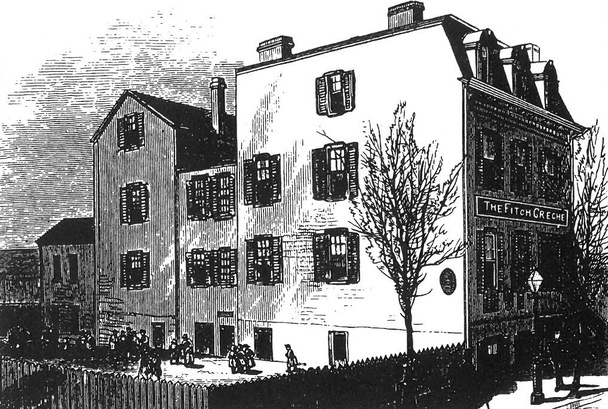
New York City taking notice of the creation of the Fitch Creche. Illustration from Frank Leslie’s Magazine 1881.
In the 1870s, there occurred a general exodus from Swan Street to the rapidly developing mansion row of Delaware Avenue. Aaron Rumsey, George Howard, Myron Bush and Sherman Jewett all relocated to the grand avenue. Samuel F. Pratt died in his Swan Street home in 1872. His widow, Mary Jane Pratt, moved into the S.V.R. Watson house on Delaware Avenue, which she later sold to The Buffalo Club. Lucius Pratt died in the 1870s and Benjamin Fitch became the owner of 159 Swan Street.
At the urging of Maria Love, Fitch donated the house to the newly formed Charity Organization Society of Buffalo. He endowed the institution called The Fitch Creche to be located in the house. On New Year’s Day 1880, a new history began for this building as the home of a nursery care educational institution for children of working mothers that was the first such to be founded in the United States and one which would serve as a model to be emulated by other American cities. It was the first to implement a Froebel kindergarten in the U.S. This important history of the building is related by Karen Little in her book on Maria Love published by the Western New York Heritage Institute in 1994.
This history of this building is immense. Its loss brought to a close a story that began with the arrival of the fur trading Revolutionary War veteran Captain Samuel Pratt in 1804. It was architecturally and culturally important and was directly related to the early marine history of this city.
On a Sunday morning, late in June, with the building more than half demolished, an ad hoc crew (consisting of Paul Redding, Scott Glasgow, Patrick Doody, Dan Patton, Bill Koch and John Conlin), came together and began working feverishly, with the owner’s permission, to save a few elements of the building. The entire Greek Revival doorway, the best that ever graced such a Buffalo building, was saved – along with its massive well-worn threshold stone. Both pairs of window sash from the dining room and the complete floor-to-ceiling molded casings of the windows were salvaged intact. The entire marble dining room fireplace mantle with its cast iron insert, the best in the house, was saved. Two interior doors and door casings were removed in the hope that all these elements could one day be employed as part of an exhibit on the early architecture of Buffalo, recreating the entranceway to the house and the entire dining room of Susan Beals Pratt. For the wall treatment, two well preserved samples of the earliest wallpaper patterns used in the house were delicately retrieved from the demolition site.
